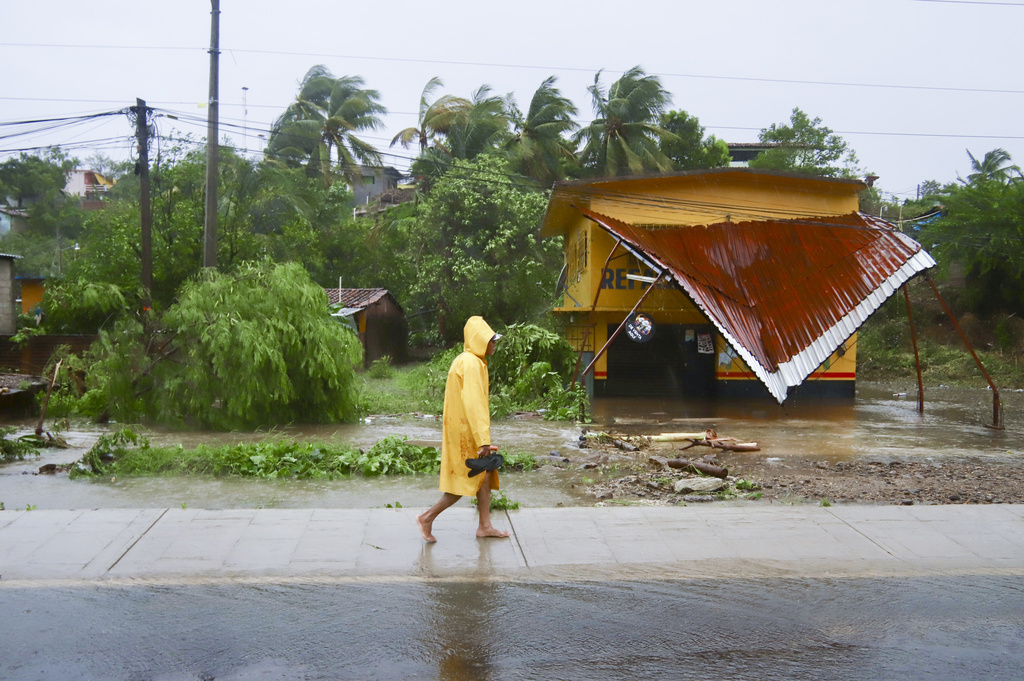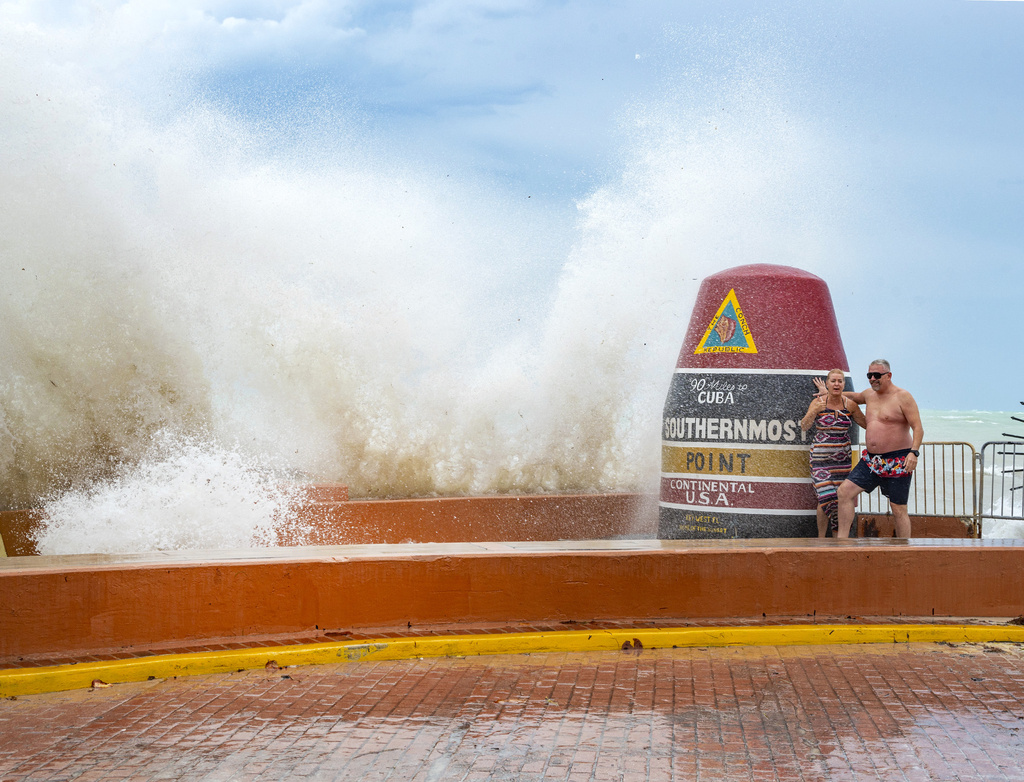Hurricane Helene Heads to Florida, Massive Storm Surge Expected \ Newslooks \ Washington DC \ Mary Sidiqi \ Evening Edition \ Hurricane Helene flooded parts of Mexico and is barreling toward Florida, where it’s expected to make landfall as a Category 3 storm. With wind speeds predicted to surpass 110 mph and storm surges potentially reaching 18 feet, officials have issued states of emergency across the Southeast. Thousands of residents are evacuating as the storm poses a serious threat to homes and infrastructure.

Hurricane Helene’s Path Quick Looks:
- Hurricane Helene swamped parts of Mexico and is now heading for Florida, expected to make landfall as a Category 3 storm.
- The storm, currently moving across the Gulf of Mexico, could create a storm surge as high as 18 feet, with winds exceeding 110 mph (177 kph).
- Residents across Florida’s Gulf Coast are evacuating, with schools closed and states of emergency declared in several southeastern states.
- Helene ranks in the 90th percentile in size, with tropical storm-force winds forecasted to extend over 200 miles.
- Florida airports in Tampa, Tallahassee, and St. Petersburg are set to close, while hospitals and nursing homes have already evacuated.
- The U.S. National Hurricane Center expects the storm to hit Florida’s Big Bend region, prompting fears of severe inland flooding.
- Mexico’s Yucatan Peninsula was also hit by heavy rains and winds, with Cuba bracing for major waves and flooding as Helene moves through.
- Helene could become the largest storm in seven years to hit the Gulf region, rivaling 2017’s Irma, 2005’s Wilma, and 1995’s Opal.
- Federal authorities are deploying search-and-rescue teams, along with power restoration crews, to impacted areas in preparation.
- Atlanta and other inland Southern cities could experience the worst hurricane conditions in decades, with rainfall predicted to reach Kentucky and Tennessee.
Deep Look:
Hurricane Helene, a massive storm currently ranked in the top 90th percentile for size, is making its way toward Florida after battering parts of Mexico’s Yucatan Peninsula. Forecasts warn that Helene will intensify into a major Category 3 hurricane as it crosses the warm waters of the Gulf of Mexico. By Thursday, it is expected to bring life-threatening storm surges and powerful winds to Florida’s Big Bend region, prompting emergency preparations across the southeastern U.S.
On Wednesday, the storm’s center was about 110 miles northeast of Cozumel, Mexico, moving at nearly 10 mph with sustained winds reaching 80 mph (130 kph). Meteorologists expect Helene’s winds to accelerate, potentially exceeding 110 mph (177 kph) before landfall. The National Hurricane Center (NHC) warned of a storm surge as high as 18 feet in some areas, which could engulf homes and disrupt critical infrastructure. Such surges, combined with heavy rainfall, threaten to cause devastating flooding well inland.
In Florida, the looming threat has sent residents scrambling to prepare. Stores saw thinning shelves as people stocked up on essentials like water and non-perishable food. Connie Dillard of Tallahassee shared her concerns, saying, “Just hope and pray that everybody’s safe.” Many residents were seen evacuating, heeding warnings from local and federal officials.
The U.S. state of Florida, accustomed to hurricanes, is bracing for the arrival of one of the largest storms in recent memory. Airports in St. Petersburg, Tallahassee, and Tampa are planning to close, while hospitals and nursing homes have evacuated vulnerable patients. A reported 18,000 linemen from other states have already been stationed in Florida, prepared to help restore power once the storm passes.
Helene’s current trajectory places it on course to hit Florida’s Big Bend area, a vulnerable stretch of coastline in the northern part of the state. Florida A&M student Kameron Benjamin, who filled sandbags with his roommate in preparation, said, “This hurricane is heading straight to Tallahassee, so I really don’t know what to expect.” As residents batten down their homes, many recalled the devastation wrought by Hurricane Michael in 2018, a Category 5 storm that devastated Panama City and the surrounding area. Helene’s size and potential damage have drawn comparisons to that storm, with experts warning that residents should not underestimate its impact.
National Hurricane Center warning coordinator Robbie Berg urged Floridians to take the storm seriously: “Please do not compare it to other storms you may have experienced over the past year or two.” With tropical storm-force winds extending for over 200 miles, Helene could become the largest storm to hit the Gulf Coast region in seven years, according to Colorado State University hurricane researcher Phil Klotzbach. In terms of sheer size, only Hurricanes Irma in 2017, Wilma in 2005, and Opal in 1995 rival Helene’s predicted scale.
The potential impacts of the storm are not limited to Florida. As it moves inland, Helene is expected to bring hurricane conditions as far north as Georgia, where residents are also being urged to prepare. Atlanta, under a tropical storm watch, could experience the worst hurricane strike on a major inland Southern city in over 35 years, said University of Georgia meteorologist Marshall Shepherd. The last comparable event was Hurricane Hugo, which hit Charlotte, North Carolina, in 1989, knocking out power to 85% of the city’s residents.
Heavy rainfall and flooding are expected to spread well beyond the immediate impact zone, with landslides predicted in southern Appalachia and catastrophic flooding likely in the Carolinas and Georgia. The governors of Georgia, South Carolina, and North Carolina have all declared states of emergency, preparing for the storm’s aftermath. Rainfall could extend into parts of Tennessee, Kentucky, and even Indiana, underscoring the widespread nature of Helene’s impact.
Before heading for the U.S., Helene formed in the Caribbean and swept along the Yucatan Peninsula, flooding streets and toppling trees near the popular tourist destination of Cancun. Cuba, too, has been hit by the storm, with waves as high as 16 feet slamming Cortes Bay. Authorities there evacuated cattle and deployed medical brigades to remote areas that could be cut off by the storm. As a precaution, some communities saw their power cut to minimize damage.
In the U.S., federal authorities have been working swiftly to position supplies and emergency teams. Generators, food, and water have been pre-positioned, alongside search-and-rescue teams and power restoration workers, ready to mobilize as soon as the storm passes.
Florida Governor Ron DeSantis, who issued an emergency declaration for most of the state, emphasized the importance of heeding evacuation orders. Several health care facilities had already evacuated, and Disney World announced limited closures for Thursday, including Typhoon Lagoon water park.
Hurricane Helene is the eighth named storm of the 2023 Atlantic hurricane season, which began June 1. According to Klotzbach, since 2000, Florida has seen eight major hurricanes make landfall, a testament to the state’s hurricane-prone status. The National Oceanic and Atmospheric Administration (NOAA) has predicted an above-average hurricane season this year, driven in part by record-warm ocean temperatures.
Helene is not the only storm making waves in the region. In the Pacific, former Hurricane John, which initially struck Mexico’s southern coast as a Category 3 storm, has re-formed as a tropical storm. The Pacific storm caused significant damage earlier this week, including mudslides and downed trees near Acapulco. On Wednesday, John re-emerged over the ocean, prompting new warnings for Mexico’s western coastline as officials braced for further damage.







